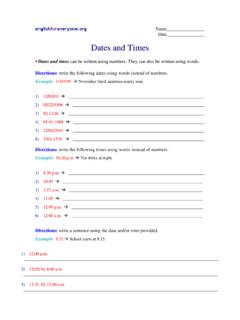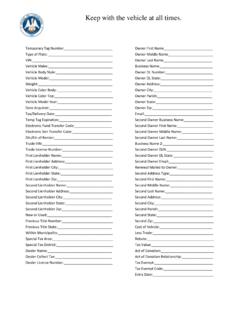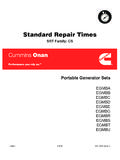Transcription of API Gear Oil Specifications
1 API gear oil Specifications API gear Oil Specifications The American Petroleum Institute (API) has a system of Specifications for classifying gear and differential oils with a GL ( gear Lubricant) rating. GL-1. Denotes lubricants intended for manual transmissions operating under such mild conditions that straight petroleum or refined petroleum oil may be used satisfactorily. Oxidation and rust inhibitors, defoamers, and pour depressants may be added to improve the characteristics of these lubricants. Friction modifiers and extreme pressure additives shall not be used. API GL-1 lubricants are generally not satisfactory for many passenger car manual transmissions.
2 However, these lubricants have been used in some truck and tractor manual transmissions. Lubricants meeting service designation API. MT-1 are an upgrade in performance over lubricants meeting API GL-1 and are preferred by major commercial vehicle manual transmission manufacturers. In all cases the transmission manufacturer's lubricant quality recommendations should be followed. GL-2. Denotes lubricants intended for automotive worm- gear axles operating under such conditions of load, temperature, and sliding velocities that lubricants satisfactory for API GL-1 service will not suffice. Products suited for this type of service contain anti-wear or film-strength improvers specifically designed to protect worm gears.
3 GL-3. Denotes lubricants intended for manual transmissions operating under moderate to severe conditions and spiral-bevel axles operating under mild to moderate conditions of speed and load. These service conditions require a lubricant having load-carrying capacities exceeding those satisfying API GL-1. service but below the requirements of lubricants satisfying API GL-4 service. gear lubricants designated for API GL-3 service are not intended for axles with hypoid gears. Some transmission and axle manufacturers specify API Category CC or CD motor oils for this service. The manufacturer's specific lubricant quality recommendations should be followed.
4 GL-4. Denotes lubricants intended for axles with spiral bevel gears operating under moderate to severe conditions of speed and load or axles with hypoid (see note) gears operating under moderate speeds and loads. These oils may be used in selected manual transmission and transaxle applications where MT-1 lubricants are unsuitable. The manufacturer's specific lubricant quality recommendations should be followed. Although this service designation is still used commercially to describe lubricants, some test equipment used for performance verification is no longer available. Procedures to define this performance are currently being reviewed for adoption by ASTM.
5 API gear oil Specifications Note: Frictional requirements for axles equipped with limited-slip differentials are normally defined by the axle manufacturer. GL-5. Denotes lubricants intended for gears, particularly hypoid (see note) gears, in axles operating under various combinations of high-speed/shock load and lowspeed/high-torque conditions. Lubricants qualified under Military specification MILL-2105D (formerly MIL-L-2105C) satisfy the requirements of the API GL-5 service designation, although the API designation does not require military approval. Performance test details are in ASTM Publication STP-512A.
6 Note: Frictional requirements for axles equipped with limited-slip differentials are normally defined by the axle manufacturer. API MT-1. Denotes lubricants intended for nonsynchronized manual transmissions used in buses and heavy- duty trucks. Lubricants meeting the requirements of API MT-1 service provide protection against the combination of thermal degradation, component wear, and oil-seal deterioration, which is not provided by lubricants in current use meeting only the requirements of API GL-1, 4, or 5. API MT-1 does not address the performance requirements of synchronized transmissions and transaxles in passenger cars and heavy-duty applications.
7 API MT-1 lubricants should not be mixed with engine oils in the same transmission unit. Transmission manufacturers' specific lubricant quality recommendations should be followed. Important: Of the original five GL ( gear Lubricant) categories, only GL-5 is still valid and verifiable. Even GL-4 is no longer valid and new oils cannot be tested to this specification because the test equipment is also no longer available. GL classifications are primarily for the American market and are no measure of synchromesh compatibility. However, it has been shown that API GL-4 oil types are more likely to be synchromesh ring- compatible because they contain fewer additives than GL-5 oils which are seldom synchromesh ring- compatible because of the high proportion of sulphur in their formulations.
8 API GL-4: Mainly manual gearboxes, moderate loads API GL-5: Mainly highly-stressed differentials and sometimes manual gearboxes (transaxles).





